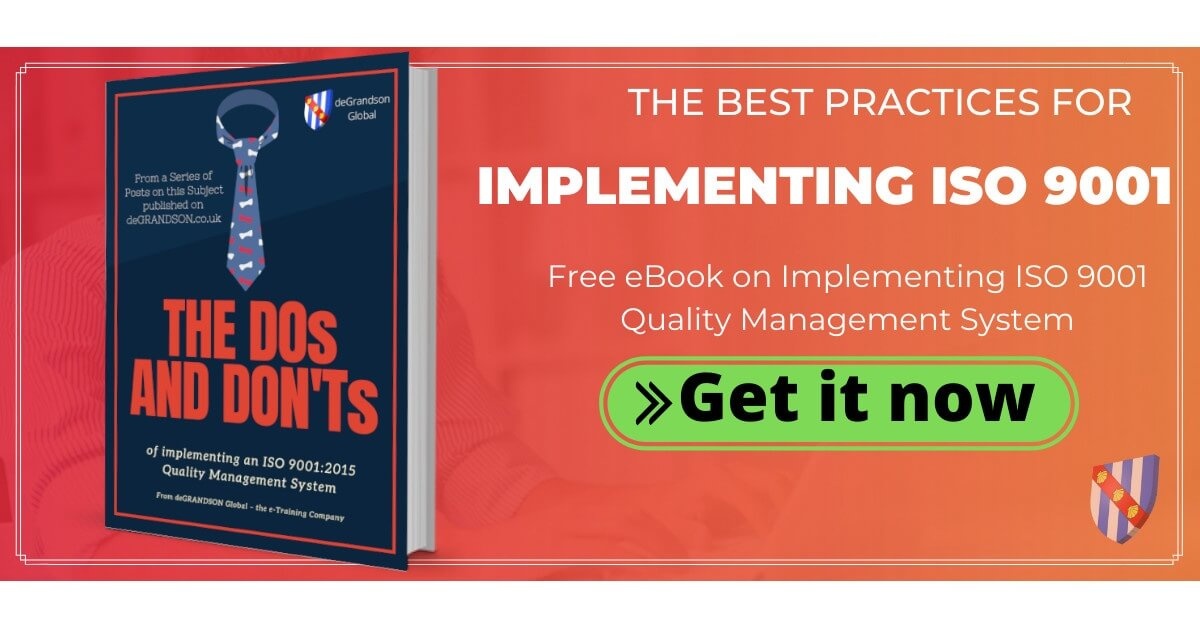Practical advice on ISO 9001:2015 Clauses 7.2, 7.3, and 7.4
ISO 9001 Clauses 7.2, 7.3, and 7.4 play a crucial role in the effective implementation and maintenance of a Quality Management System (QMS) within an organization.
ISO 9001 Clause 7.2 emphasizes the importance of having competent personnel within an organization.
ISO 9001 Clause 7.3 emphasizes the importance of ensuring that all employees are aware of the QMS and their role in contributing to its effectiveness.
ISO 9001 Clause 7.4, meanwhile, addresses the need for effective communication both internally within the organization and externally with relevant parties.
NOTE: The advice given here also applies to ISO 14001, ISO 27001, ISO 45001 and other standards having the same HLS structure as ISO 9001.
Table of Contents
- Key Elements of ISO 9001 Clauses 7.2, 7.3, and 7.4
- How to Meet the Requirements of ISO 9001 Clauses 7.2, 7.3, and 7.4
- DO's and DON'Ts for Implementation
- Documents that Prove Compliance with ISO 9001 Clauses 7.2, 7.3, and 7.4
Key Elements of ISO 9001 Clauses 7.2, 7.3, and 7.4
ISO 9001:2015 Clause 7.2: Competence
- Identifying Necessary Competence - involves outlining the skills, knowledge, training, and experience personnel need to perform their roles effectively.
- Ensuring Competence: - involves making sure that employees have the required competencies to fulfill their roles effectively and, if not, that they get the appropriate training, education, or experience they need to acquire the said competencies.
- Evaluating Competence: This involves conducting periodic evaluations and assessments of personnel competence to ensure that they continue to meet the requirements of their individual roles.
- Maintaining Records: involves maintaining documents demonstrating staff competence including training records, certifications, qualifications, and performance evaluations.
ISO 9001:2015 Clause 7.3: Awareness
- Quality Policy and Objectives: This involves outlining your organization's specific objectives and related policies and helping employees understand how their roles fit into the equation.
- Implications of Non-conformance: involves making staff aware of the possible consequences of not following the QMS requirements and its potential impact on product or service quality and customer satisfaction.
- Communication of Awareness: involves effectively communicating relevant information about the QMS to employees to ensure that everyone knows how their individual actions can affect the overall effectiveness of the QMS.
ISO 9001:2015 Clause 7.4: Communication
- Internal Communication: involves setting up communication processes to make sure that quality objectives, roles, responsibilities, and performance are effectively communicated to all members of the organization.
- External Communication: involves ensuring that external parties, such as customers, suppliers, and regulatory authorities, are kept up-to-date regarding matters related to the QMS, product or service information, customer feedback, complaints, or any other relevant issues.
- Documented Information: involves maintaining documented information related to communication processes and ensuring they are accurate, timely, and accessible to those who need it within and outside the organization.
How to meet the requirements of ISO 9001 Clauses 7.2, 7.3, and 7.4
ISO 9001 Clause 7.2 Compliance
Your organization can use different strategies to determine the skills, knowledge, qualifications, and experience required for specific job roles.
For example, a production supervisor in a manufacturing plant may need expertise in process optimization, quality control, and team management while a software engineer in a software development firm may require proficiency in coding languages, software design, and problem-solving skills.
This can be done by conducting skills assessment surveys or questionnaires for employees. For example, you can ask them which parts of their jobs they find the easiest to manage and which parts they struggle with.
By understanding employee strengths, weaknesses, and areas for improvement according to their roles, your organization can identify what additional training is needed to address skill gaps among employees from all levels of the organization.
Additionally, external benchmarks and industry standards can be used to determine which competencies are crucial for competitiveness or compliance in specific industries.
For example, engineering firms may align required competencies with industry standards, while accounting firms may match essential skills to meet evolving financial regulations.
ISO 9001 Clause 7.3 Compliance
Ensuring that all members of the organization are made aware of the quality policy is critical to the success of your Quality Management System. You can do this by conducting training sessions or workshops to emphasize the importance of the quality policy and its alignment with business objectives.
For example, an online training module for IT professionals can highlight how following quality procedures ensures bug-free software, enhanced user experience, and increased customer satisfaction. Similarly, healthcare-focused seminars or conferences can emphasize how compliance with the policy contributes to reducing medical errors, improving patient outcomes, and maintaining regulatory compliance.
With that said, promoting awareness about the consequences of non-conformance is just as important as making employees understand the importance of the quality policy.
For example, workshops can provide opportunities to demonstrate how errors or non-compliance can directly impact the quality of products and services and eventually affect customer satisfaction. Actual case studies highlighting the consequences of not adhering to established quality procedures are another example.
ISO 9001 Clause 7.4 Compliance
Using various channels to enable quick and seamless dissemination of organization-related updates helps reinforce the importance of ongoing quality initiatives.
For example, making the Quality Policy document available via the company intranet or by posting it in common areas most frequented by employees like waiting areas, nursing stations, or break rooms in hospitals or other healthcare facilities and meeting rooms, cafeterias, coffee stations, walkways in IT firms can be an excellent way to start. Raising concerns about quality objectives, individual roles and responsibilities, and performance evaluations in regular team meetings is another.
Externally, maintaining active communication channels is essential for engaging stakeholders outside the organization. For example, regular customer feedback surveys allow the collection of valuable insights into product or service quality, allowing relevant departments to address identified issues or implement improvements promptly.
Additionally, keeping external stakeholders informed of matters related to the company by conducting annual third-party audits, participating in regular compliance reports, and actively joining regulatory meetings communicates your organization's commitment to transparency.
Do's and Don'ts of Implementing ISO 9001:2015 Clauses 7.2, 7.3, and 7.4
DO's
- Do create an Organization Chart. If this has not been done before, expect this to be a challenging task and involve your colleagues – people are sensitive about their jobs especially when they’re ill-defined.
- Create job descriptions for each position on the organizational chart.
- Do ensure that the Job Descriptions include specifics. These include:
- Job Title
- Qualifications and experience required (minimum)
- Role, responsibilities and duties
- Authorities
- Do make sure that all personnel are aware of their responsibilities and authorities. This includes those engaged on a contractual, temporary, voluntary basis,
- Do make sure that all personnel are trained in their Job Descriptions (and create corresponding records).
- Do make sure that all personnel are trained in the principal Procedures and methods applicable to their job descriptions (and create corresponding records). This is a frequent omission found in external audits.
- Do use your Training Records to record Competency Checks. These are more credible if the check is done by someone other than the Trainer, say, the Supervisor or Manager of the Trainee.
- Do include essential, routine internal and external communication in the Job Descriptions. For example, who is responsible for communication plans to those who will implement them; who is responsible for communicating with customers on commercial matters; who is responsible for communicating with suppliers on technical matters; and so on.
DON’Ts
- Don’t omit Authorities from your Job Descriptions – another frequent omission.
- Don’t ignore the checklist, a) through d), of clause 7.3 Awareness. Include it in your internal audit.
- Don’t ignore the implications of not conforming to the quality management system requirements. Personnel need to know the consequences for the organization, at least in general terms, of not following procedures, of exceeding their authority, etc. External auditors frequently use this as a check of the level of Awareness.
- Don't rely on only one communication channel. Overlooking other communication methods might prevent a comprehensive understanding of your organizational objectives and policies.
- Don't make vague statements related to quality objectives, roles, or responsibilities. It can lead to misunderstandings or improper execution of tasks.
- Don't forget to update documented information with the latest changes. Failing to do so can lead to outdated information, confusion, or non-adherence to current standards.
- Don't be too rigid in implementing quality initiatives. Dismissing non-conventional approaches without exploring their potential first can stifle innovation and improvement opportunities.
Documents that can prove compliance with ISO 9001 Clauses 7.2, 7.3, and 7.4
There are several documents that can help prove your organization's compliance with these clauses.
ISO 9001 Clause 7.2 Documentation:
- Training Records: includes documentation of training programs, workshops, and courses employees attended to acquire necessary skills, knowledge, and qualifications.
- Competence Assessments: includes records of assessments conducted to evaluate the competence of employees, including skills assessments, performance reviews, and evaluation reports.
- Job Descriptions: includes clear and detailed descriptions of job roles and responsibilities outlining the required competencies for each position within the organization.
ISO 9001 Clause 7.3 Documentation:
- Quality Policy Document: contains a written declaration outlining your organization's commitment to quality, including your objectives, principles, and commitment to meeting quality standards.
- Communications Records: contains records of communication processes used to distribute information about the QMS, including emails, newsletters, meeting minutes, or intranet posts.
- Training Materials: includes materials used in training sessions or workshops to explain the quality policy, objectives, and employees' individual roles.
ISO 9001 Clause 7.4: Documentation:
- Competence Needs Assessment Reports: contains reports on how competence needs were identified, including the performance of job role analyses, skills gap assessments, and their impact on QMS performance.
- Training Program Records: includes documents related to training initiatives, educational programs, and qualifications acquired by employees to address competency gaps.
- Mentoring and Coaching Plans: includes records detailing mentoring programs, coaching sessions, and on-the-job experience strategies implemented to address competence gaps.
- Records of Knowledge-Sharing Initiatives: includes documentation of knowledge-sharing sessions, including what platforms were used or summaries of what were discussed.
Conclusions
For successful ISO 9001 implementation, training records are not sufficient to demonstrate competency, awareness and communication.
The consequence of the 2015 version of the Standard having separate clauses for Competence, Awareness and Communication is that external auditors will seek objective evidence that each of the three requirements is being complied with. So, you will need to address each separately and have evidence, in each case, to back up your claims of compliance.
For more visit here.
Related Courses
Related Articles
- ISO 9001 Clauses
- ISO Internal Auditor Training - 5 Reasons Why it's a 'Must'
- ISO 9001 Training and Certification Overview
- Free ISO 9001 Implementation Handbook (100+ pages)
- [Update] Seventeen official ISO 9001 Guidance Documents
deGRANDSON Global is an ISO Certified Educational Organization
In October 2021 we secured certification to three education-related ISO Standards. We now have a university-grade management system in place conforming to the requirements of …
We have chosen ISO 21001 certification because, unlike IRCA and Exemplar badges (which in our opinion are commercially compromised), it is based on independent third-party assessment. It is a ‘university grade’ standard in use globally by schools, colleges, and universities to demonstrate their competence.
We offer Courses for ISO 9001, ISO 13485, ISO 14001, ISO 17025, ISO 27001, ISO 45001, Data Protection, Risk Management more.






